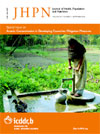
|
The Journal of Health, Population and Nutrition
icddr,b
ISSN: 1606-0997
EISSN: 1606-0997
Vol. 28, No. 4, 2010, pp. 405-412
|
 Bioline Code: hn10053
Bioline Code: hn10053
Full paper language: English
Document type: Research Article
Document available free of charge
|
|
|
The Journal of Health, Population and Nutrition, Vol. 28, No. 4, 2010, pp. 405-412
| en |
Understanding below-replacement fertility in Kerala, India
Nair, P. Sadasivan
Abstract
Kerala is well-known globally for the unprecedented fertility transition in the Indian subcontinent towards the end of the last century. The state has already reached below-replacement fertility level in the 1990s while the rest of India was experiencing high or mid-level fertility. With this backdrop, an attempt was made in this paper (a) to explore the plausible factors associated with sub-replacement fertility and consequent population momentum in Kerala and (b) to trace their socioeconomic and health policy implications. The underlying factors that led to the fertility transition was explored and discussed in some detail. An enhanced level of human development achieved during the last quarter of the 20th century, mainly through developments in social and health sectors, is likely to be the main contributor. Unlike other states in India, there were historical factors as well that functioned as a catalyst for this, such as widespread education and women′s empowerment. As an inevitable demographic impact, population growth due to momentum is expected to be very strong in Kerala with an age-structural transition favouring the old. The so-called ′demographic dividend′ invoked by the increase of labour-force derived from the youth bulge in the age-structure is being lost in the state due to very limited capital investments and political will. Again, as a direct consequence of population growth, population density in Kerala will take a staggering level of 1,101 persons per sq km in 2026. The ill effects of environmental deterioration and consequent changes in morbidity patterns will have to be dealt with seriously. The very foundations of health policy needs revamping in the light of demographic changes associated with sub-replacement fertility. The tempo of population-ageing is very high in Kerala. The proportion of population aged 60+ years is likely to be 20% in 2026 whereas it will be around 12% only in India. The current level of social and health infrastructure in the state may not be sufficient to cope with the emerging demands of population-ageing since the financial and morbidity burdens of the elderly are already quite high. To conclude, Kerala portrays a typical case of the vagaries of the onset of sub-replacement fertility level in the absence of reasonable structural changes in the economic and health fronts.
Keywords
Aging; Demographic transition; Fertility; Human development; Morbidity; Population growth; India
|
| |
© Copyright 2010 Journal of Health Population and Nutrition.
Alternative site location: http://www.jhpn.net
|
|
